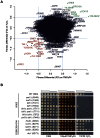Pentose phosphate pathway function affects tolerance to the G-quadruplex binder TMPyP4
- PMID: 23776642
- PMCID: PMC3680382
- DOI: 10.1371/journal.pone.0066242
Pentose phosphate pathway function affects tolerance to the G-quadruplex binder TMPyP4
Abstract
G-quadruplexes form in guanine-rich regions of DNA and the presence of these structures at telomeres prevents the activity of telomerase in vitro. Ligands such as the cationic porphyrin TMPyP4 stabilise G-quadruplexes and are therefore under investigation for their potential use as anti-cancer drugs. In order to investigate the mechanism of action of TMPyP4 in vivo, we carried out a genome-wide screen in the budding yeast Saccharomyces cerevisiae. We found that deletion of key pentose phosphate pathway (PPP) genes increased the sensitivity of yeast to the presence of TMPyP4. The PPP plays an important role in the oxidative stress response and sensitivity to TMPyP4 also increased when genes involved in the oxidative stress response, CCS1 and YAP1, were deleted. For comparison we also report genome wide-screens using hydrogen peroxide, which causes oxidative stress, RHPS4, another G-quadruplex binder and hydroxyurea, an S phase poison. We found that a number of TMPyP4-sensitive strains are also sensitive to hydrogen peroxide in a genome-wide screen. Overall our results suggest that treatment with TMPyP4 results in light-dependent oxidative stress response in budding yeast, and that this, rather than G-quadruplex binding, is the major route to cytotoxicity. Our results have implications for the usefulness and mechanism of action of TMPyP4.
Conflict of interest statement
Figures






References
-
- Izbicka E, Wheelhouse RT, Raymond E, Davidson KK, Lawrence RA, et al. (1999) Effects of cationic porphyrins as G-quadruplex interactive agents in human tumor cells. Cancer research 59: 639–644. - PubMed
-
- Martino L, Pagano B, Fotticchia I, Neidle S, Giancola C (2009) Shedding light on the interaction between TMPyP4 and human telomeric quadruplexes. The journal of physical chemistry B 113: 14779–14786. - PubMed
-
- Wei C, Wang L, Jia G, Zhou J, Han G, et al. (2009) The binding mode of porphyrins with cation side arms to (TG4T)4 G-quadruplex: spectroscopic evidence. Biophysical chemistry 143: 79–84. - PubMed
-
- Wei C, Jia G, Yuan J, Feng Z, Li C (2006) A spectroscopic study on the interactions of porphyrin with G-quadruplex DNAs. Biochemistry 45: 6681–6691. - PubMed
-
- Han FXG, Wheelhouse RT, Hurley LH (1999) Interactions of TMPyP4 and TMPyP2 with quadruplex DNA. Structural basis for the differential effects on telomerase inhibition. Journal of the American Chemical Society 121: 3561–3570.
Publication types
MeSH terms
Substances
Grants and funding
LinkOut - more resources
Full Text Sources
Other Literature Sources
Molecular Biology Databases

